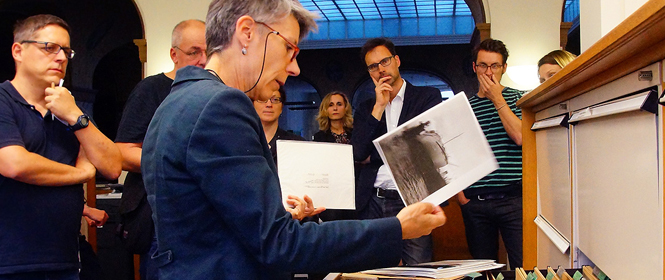
BLOGGERS’ TOUR OF THE IMAGE ARCHIVE
The image archive of Deutsches Historisches Museum (DHM) performs two key functions. It is the first port of call for obtaining images of the museum’s objects and also looks after the museum’s extensive photographic collection. It is home to such gems as the bequests of press photographers and press agencies, as well as the image archive of the former Museum für Deutsche Geschichte (MfDG).
On this evening tour, Collection Head Carola Jüllig explains the story of the archive’s inception to a selected group of bloggers. It was established in 1991 to systematically order the photographs of DHM collection items that had been taken since 1987. It was also tasked with archiving the object documentation of the former Museum für Deutsche Geschichte (MfDG) and its photographic collection covering the German and international labour movement and general GDR history, as well as archiving the documentation of the militaria collection at the former royal Prussian arsenal (Zeughaus).
The Collection Head showed the bequests of press photographers and agencies such as the archive of the Schirner photographic agency comprising 1.5 million negatives, the archive of the Schostal agency and the archive of GDR photo journalist Martin Schmidt with negatives of some 40,000 images documenting social and political life in the GDR between 1958 and 1989, with a focus on agriculture. The envelopes and boxes that she takes down from the shelves document the contemporary and cultural history of Germany. In total, they represent the country’s photographic memory.
Carola Jüllig is especially proud of the unique collection of more than 10,000 glass stereo slides known as the ‘Kaiserpanoramas’ – the largest collection of stereo photographs in Germany. Objects from this collection can also be admired on the first floor of the permanent exhibition. The images are held between two glass plates, with some of them showing their age. In order to protect and preserve the sensitive photos on a permanent basis whilst making them accessible to the public, the archive is currently in the process of being digitalised.
The numerous objects in the image archive are exceptionally sensitive and must be looked after with great care. In order to make these images from the pre-digital era available to future generations, they have to be transferred, placed in plastic sleeves, packaged in acid-free archival boxes, digitalised and moved to air-conditioned depots. All this represents a unique challenge – and one that Carola Jüllig and her team face on a daily basis.